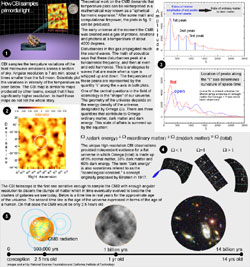 |
|
|
 |
||
|
| ||||||||||
|
News ImagesThe images below are being made available to News Media Only in advance of the press conference. Image credit: NSF/K.Woellert.
The Universe at 300,000 years old.
The CBI imaged the cosmic microwave background radiation
from three patches of sky each about 2 degrees square
(four times the diameter of the Moon, indicated with
white circle); this shows one patch. The colors represent
the intensity of the radiation, with red indicating
cool spots and white hot spots. The fluctuations in
intensity are only about 100 ľK above and below the
average temperature of 2.73 K. This image, with a
resolution of 7 minutes of arc, is the sharpest and
most sensitive yet made of the point at which photons
were first emitted 14 billion years ago. As the universe
expanded, the gravity of dark matter within the clumps
made them collapse into clusters of galaxies.
Power spectrum of the primordial radiation.
The fluctuations in temperature of the cosmic microwave
background are due to sound waves in the early universe,
created as the hot plasma oscillated under the force
of gravity created by dark matter. The angular spectrum,
shown here, indicates the intensity of the oscillations
at different wavelengths. The error bars (blue and
green) show the CBI measurements, while the two curves
(red and black) show the predictions of two cosmological
models with slightly different values of the cosmic
parameters (densities of baryons, cold dark matter,
and dark energy). Power is plotted versus multipole
number l, with higher l corresponding to finer-scale
structure in the images.
The CBI probes short-wavelength oscillations.
This diagram shows the new CBI measurements of the
cosmic microwave background power spectrum compared
with the best previous measurements, from the DASI
interferometer at the South Pole, and the BOOMERANG
and MAXIMA bolometer detectors that were carried above
the atmosphere on balloons. The CBI results are in
good agreement with the earlier measurements, which
showed the first two or three peaks in the spectrum.
However, for the first time the CBI has detected the
higher "overtones" and the drop in the spectrum on
small angular scales.
The Cosmic Background Imager consists
of 13 separate radio antennas on a single mount that
can be pointed to a particular direction in space.
Each antenna is a 90-cm parabolic reflector enclosed
in a shield can and protected by a teflon cover that
is transparent to radio radiation. The signals from
each pair of antennas are combined in a correlator
which rejects the constant part of the microwave background
and radiation from the ground and the atmosphere.
The resulting numbers are processed to make images
and further analyzed in supercomputers to extract
the all-important power spectrum.
The CBI dome. Each evening the observers
drive up to the high plateau from their headquarters
in San Pedro de Atacama, open the retractable dome
that protects the CBI from wind and snow, and start
recording data as the sun sets. The control room and
laboratory are within shipping containers grouped
around the base of the dome. Larger versions of all images from this document (Total Size: 356KB) For additional images and other versions
of these images, see http://www.astro.caltech.edu/~tjp/CBI/press/press.html
Cosmic Background Imager - SpokespersonsTeam Members:Anthony C. S. Readhead Timothy Pearson John E. Carlstrom J. Richard Bond Jorge May and Leonardo Bronfman Independent Commenters:Alan H. Guth John Mather Press Contacts:Amber Jones Robert Tindol
|
||||||||||
|
| ||||||||||
| |





